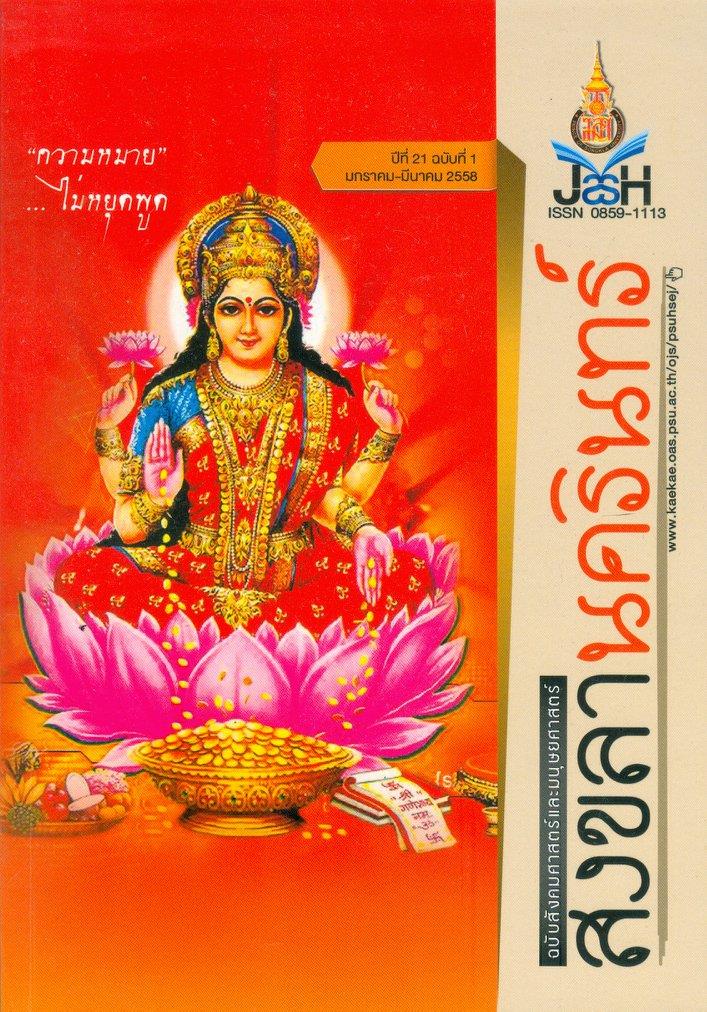<b>แนวโน้มการบริโภคเนื้อแพะและแกะในพื้นที่จังหวัดชายแดนภาคใต้</b><br> Trends in Goat Meat and Mutton Consumption in the Southernmost Provinces
Abstract
The objectives of this research were to study trends in goat meat and mutton consumption in middle-income consumers in five southernmost provinces (Yala, Narathiwas, Pattani, Songkhla and Satun); Consumer Behavior; factors affecting consumption and problems and obstacles of the consumption. Data were collected by using structured questionnaire from samples of 570 consumers. The statistics used for data analysis were percentage, mean, standard deviation and chi-square analysis. The results revealed the consumer samples that 63.30 % of the consumers consumed goat meat, 34.40 % consumed both goat meat and mutton and 2.30 % consumed only mutton. The majority of them prefer to buy live male native animals, 2-3 year olds with 20.26 Kg of body weight. The consumers also liked to buy the animals from local farms. Slaughtering and dissecting of the live animals must be done by Muslims in compliance with religious belief. The frequency of consumption for goat meat was 2-3 times whereas that for mutton was once annually. Place and price were effective factors concerning mutton and goat meat consumption behavior. In the future, goat meat and mutton consumption were focused to increase 2.03 and 1.52 times, respectively. Problems and obstacles that consumers faced include few accessibility to the market; high price of goat meat and mutton; and goat meat and mutton products were less diversified. Therefore, the government should encourage commercial sheep and goat farming, were respond to increasing demands of consumers.
<br><br> Keywords: consumer behavior, goat meat,
mutton, trend of the tonsumption,
southernmost province
<br><br>
<b> บทคัดย่อ</b><br>
งานวิจัยนี้มีวัตถุประสงค์ เพื่อศึกษาพฤติกรรมการบริโภค ปัจจัยที่มีอิทธิพลต่อการบริโภค แนวโน้มการบริโภค และปัญหา อุปสรรคในการบริโภคเนื้อแพะและแกะของผู้บริโภคที่มีรายได้ระดับกลาง ใน 5 จังหวัดชายแดนใต้ (ยะลา นราธิวาส ปัตตานี สงขลา และสตูล) เก็บรวบรวมข้อมูลจากผู้บริโภค 570 ราย โดยใช้แบบสอบถามเชิงโครงสร้าง วิเคราะห์ข้อมูลโดยใช้ค่าสถิติร้อยละ ค่าเฉลี่ย ส่วนเบี่ยงเบนมาตรฐาน และสถิติไคสแควร์ ผลการวิจัย พบว่า ผู้บริโภคกลุ่มตัวอย่าง
นิยมบริโภคเนื้อแพะ ร้อยละ 63.33 รองลงมาบริโภคทั้งเนื้อแพะและแกะ ร้อยละ 34.39 และบริโภคเนื้อแกะเพียงอย่างเดียว ร้อยละ 2.28 ส่วนใหญ่นิยมซื้อเนื้อแพะและแกะแบบเป็นตัวมีชีวิต เพศผู้ พันธุ์พื้นเมือง อายุ 2-3 ปี มีน􀃎้ำหนักเฉลี่ย 20-25.9 กิโลกรัมต่อตัว โดยซื้อจากฟาร์มในท้องถิ่น ช􀃎ำแหละโดยคนไทยมุสลิม วัตถุประสงค์เพื่อใช้ประกอบพิธีกรรมทางศาสนาเป็นหลัก ความถี่ในการบริโภคเนื้อแพะ 2-3 ครั้งต่อปี และเนื้อแกะ 1 ครั้งต่อปี ปัจจัยการตลาดด้านสถานที่จ􀃎ำหน่าย และราคามีผลต่อพฤติกรรมการบริโภคเนื้อแพะ และแกะ ส่วนปัจจัยด้านอายุ อาชีพหลัก รายได้ครัวเรือนและการรับรู้ข้อมูลข่าวสารมีอิทธิพลต่อปริมาณการบริโภคเนื้อแกะอย่างมีนัยส􀃎ำคัญทางสถิติที่ α = 0.05 ส􀃎ำหรับแนวโน้มการบริโภคเนื้อแพะและแกะเพิ่มขึ้น 1.52 และ 2.03 เท่า ตามล􀃎ำดับ ส􀃎ำหรับปัญหา อุปสรรคในการบริโภคเนื้อแพะและแกะ ได้แก่ แหล่งจ􀃎ำหน่ายมีน้อย ราคาสูงและ ผลิตภัณฑ์ไม่มีความหลากหลาย ดังนั้นภาครัฐบาลควรส่งเสริมให้เกษตรกรเลี้ยงแพะและแกะเชิงพาณิชย์ เพื่อตอบสนองความต้องการของผู้บริโภคที่เพิ่มขึ้น
<br><br> คำสำคัญ: จังหวัดชายแดนใต้, พฤติกรรมการบริโภค, แนวโน้มการบริโภค, เนื้อแกะ, เนื้อแพะ











